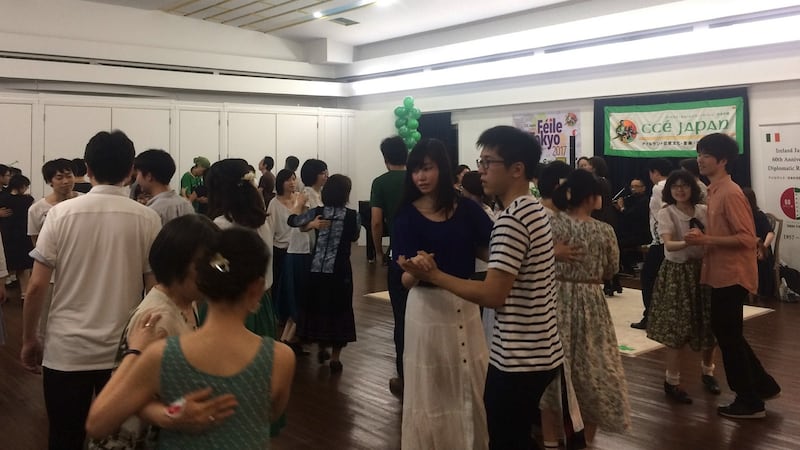I stand at the edge of the dance floor, thinking that this isn't really like the Gaeltacht céilís of my youth. There are several differences: the dancers are confident and know all the steps, the age range is far wider than secondary school teenagers, everyone is Japanese, and I'm in Tokyo.
This is Féile Tokyo's second year. I'm not homesick yet; I only left Galway for Japan two days previously. But I'm a mix of Irish and Japanese —an Irish mother, a Japanese father— so I'm always particularly interested in any other fusion of the two.
This isn’t as much a fusion as it is a transplantation. I’d assumed I could jump in and whirl about, but I was late. I’m still on Irish time (not the time zone, but in considering half an hour late is still punctual enough), which wasn’t helped by the confusion of train connections from Kokunbunji to Nakano to Waseda.
I’m welcomed warmly by Yasuko Teramachi of Comhaltas Ceoltóirí Éireann Japan, the organisation that holds the Féile. CCÉ is very good at being Irish, and have literal proof of this; they were awarded “Best Irish” of the Tokyo St Patrick’s Day parade earlier this year.
I’m asked if I play an instrument.
“No.”
But do I dance?
“Sometimes,” I say. “At weddings. But I haven’t – “had anything to drink, I’m about to say, but the refreshments I can see are all conspicuously non-alcoholic. “– haven’t done that in a while,” I finish instead. “I’m Irish, though.”
This is met with a smiling sort of puzzlement that I could blame on my halting Japanese, if it hadn’t always been the general response. Everyone else is displaying far more Irishness than I am, in twos and fours around the room. I admire the exuberance of the dancers and the music, and try not to look too awkward as I hang around without a partner. It’s beginning to feel more like one of my Gaeltacht céilís now.
It’s with a little relief I spot Oisín MacDiarmada and Samantha Harvey, the fiddler and dance teacher who have been brought over from Sligo to teach lessons – they were here last year, too. We talk about the enthusiasm and talent of the students, some of whom have taken classes with them in Ireland. They’re pointed out to me: a lovely fiddler, a fantastic step dancer.
I find out that I missed the session the night before in The Dubliner pub.
“There’s none tonight. The contests are tomorrow, so the musicians can’t drink alcohol tonight,” Yasuko tells me.
“Oh yes,” I agree. “Of course.”

The winners of the contests go forward to the Fleadh Cheoil, if they can make it to Ireland. The pianist playing with the band, Tomomi Oda, had competed at last year’s Fleadh, where she had apparently “caused a stir”. She was barefoot, and played trad with a jazz influence. Japan loves jazz. I listen, and think I can hear it.
I strike up conversation with Mariko Tatsuoka, a fiddler who lived in Galway and then Ennis for a year. I ask her when she started loving Irish music.
She closes her eyes and places her hand on her heart. “When I was younger, the supermarket we shopped in played Dervish.”
Mariko wants to move back to Ireland, but is still working out how she could do that. “I didn’t find an Irish boyfriend when I was there,” she says.
I go to say hello to the musicians, the Toyota Céilí Band. My father grew up in a town not far from the city of Toyota, but I find they’re not from there; they’re led by Kozo Toyota, the whistle player.
“There are Kumagais here,” he says, referring to my family name. “A father and son. Two of the best dancers I have seen.” I have a feeling I am not related to them.
The last set ends with a flourish and everybody claps and collapses, dancers and musicians wiping sweat from foreheads. Yasuko tells me to come again; in fact, the Irish Ambassador would be there tomorrow, because it’s the 60th anniversary of Irish-Japanese diplomatic relations. It’s strange, really; only 60 years.
I leave for the subway. It's three three trains back to the university where I'm teaching for the summer. I'm leading a course in creative writing—emphatically in English, given my lack of Japanese. I didn't speak it growing up and now I'm learning, but it's difficult. My brain feels slow, a step behind the rapid speech. I understand more than I can say so often I just nod along. It makes me more gaijin here, a word that, when written in kanji, means literally outside person.
I didn’t feel Irish enough at the Gaeltacht; now it turns out I don’t feel Irish enough in Tokyo. Note to self: learn the Siege of Ennis properly, also become fluent in Japanese. I think of the céili pianist, the echo of a jazz bounce she put on the lively trip of the reel, and now I’m tapping my foot on the Shinjuku line. That’s how you combine two arts and cultures; one strengthens the other, like a harmony. It does make me want to dance.


















